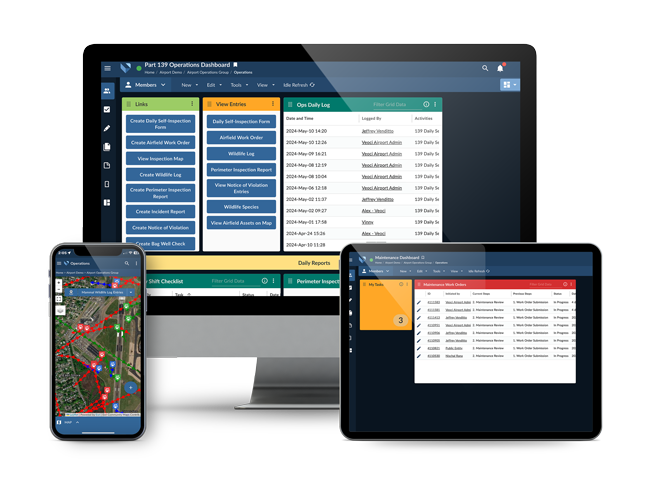Veoci works with 180+ airports globally
Paper reports and uncoordinated systems only hinder airport operations. Veoci solutions, developed by practitioners, save airports and their personnel meaningful time and funds every day. Digitizing critical processes puts inspection forms, reporting, escalations, and communications into the pockets of all airport personnel, and makes a measurable difference in all airfield, landside, safety, and administrative operations.

An all-in-one solution for any size airport
Modern and user-friendly solutions
Usable solutions matter most for daily operations. Veoci’s solutions streamline those inspections and simplify collaboration, giving airport teams back time during the day and funds week after week.
We replicated and digitized critical inspection and operational forms, putting each one into the pocket of personnel via the Veoci mobile app on tablets and phones. No need to run back to an office for more copies. Complete one inspection in the airfield, and move on to the next.
Visualize your airfield. Layers and icons transform your data into complete maps that can show assets on the airfield, the locations of work orders, statuses, areas and boundaries, wildlife trends, and more. Drill down within the maps too to display information directly from the map without having to navigate elsewhere.
Whether it’s for an AEP activation or a work order assignment, get eyes of personnel on critical information instantly. Email. text, phone, and push notifications provide multiple channels for outreach. Lists also streamline the process, sending notifications out to large pools of people in just a few clicks. Reminders help keep you and your team in front of permit expirations, work orders, submission deadlines, and more. Simple email notifications keep time sensitive dates top-of-mind.
Airports use a number of tools for operations and processes. Integrate your existing tools and data with your Veoci solutions to streamline operations even more, and prevent bottlenecks of data and information from materializing.
Connect all of your solutions to create a single home base and storehouse for information. Veoci helps airports make data interoperable and keep processes moving, kicking off assessments, downstream inspections, notifications, work orders, and more when necessary.
Work on the go. Rooms are virtual hubs for all operations and communications, letting personnel remotely coordinate and exchange updates as they work. Share information between shifts or see the status of work orders and inspections. Everything is accessible via Veoci’s mobile app.
Breakdown data silos. Roll up data from inspections and other operations into real-time reports; management, the FAA, or other personnel can quickly get all of the information they need in just one click. Reclaim time by eliminating the need for time-consuming updates and manual reports.

Real world applications

Hawaii Provides State-Owned Airports with Online Platform for Environmental Systems Management
The Hawaii Department of Transportation moved 15 airports across Hawaii from paper processes and file cabinets to a digital, always-available platform with all operations data, processes, inspection forms, and more.
The Veoci Difference
Our Aviation team has decades of combined experience in aviation, airport operations, and airport management, which helps them create solutions our customers can trust to make an impact.

Dia Wynn
Former Manager of Airfield Operations at SFO

Alex Nguyen
Former Airport Operations Manager

Andrew Hoppe
Airport and Airline operational systems, product, and go-to-market strategy

Vincent Jessel
Private Pilot License and Instrument Rating from the FAA

Brian Barnes
Former Air National Guard pilot, commercial pilot, and airport manager
Aviation Case Studies
How Can Veoci Help You?













